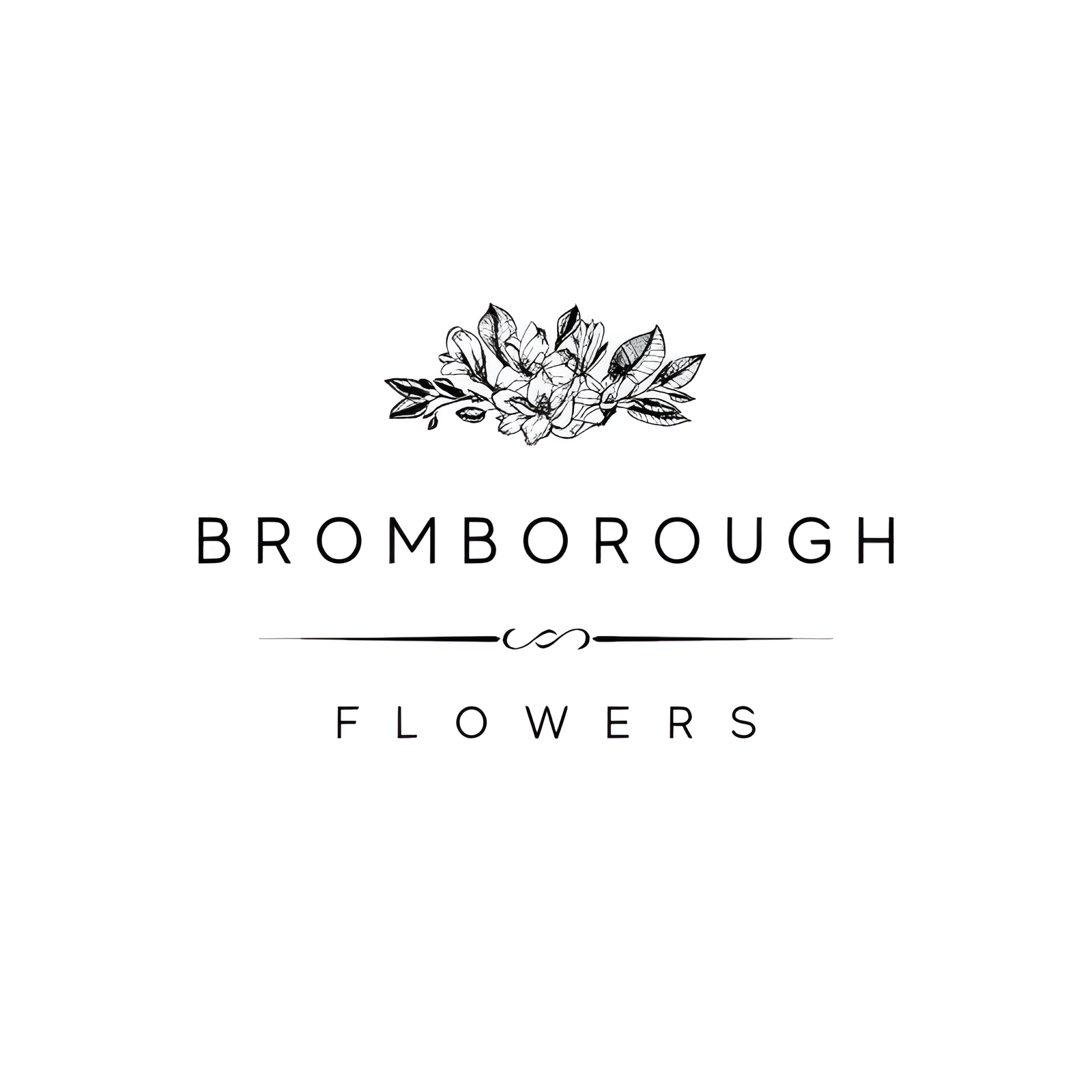The Ranunculus, a flower of choice for many brides, offers a sophisticated and multifaceted addition to any wedding floral arrangement. Known for its intricate, layered petals and vibrant array of colors, this bloom not only symbolizes radiant charm but also provides an enduring elegance. Originating from the Latin name *Ranunculus asiaticus*, these flowers thrive in specific growing conditions, which are essential to understand for best use in wedding decor. As we explore the various aspects of the Ranunculus, one will discover why it stands out amidst other floral options and how it can elevate the aesthetic of any matrimonial celebration.
Flower Overview
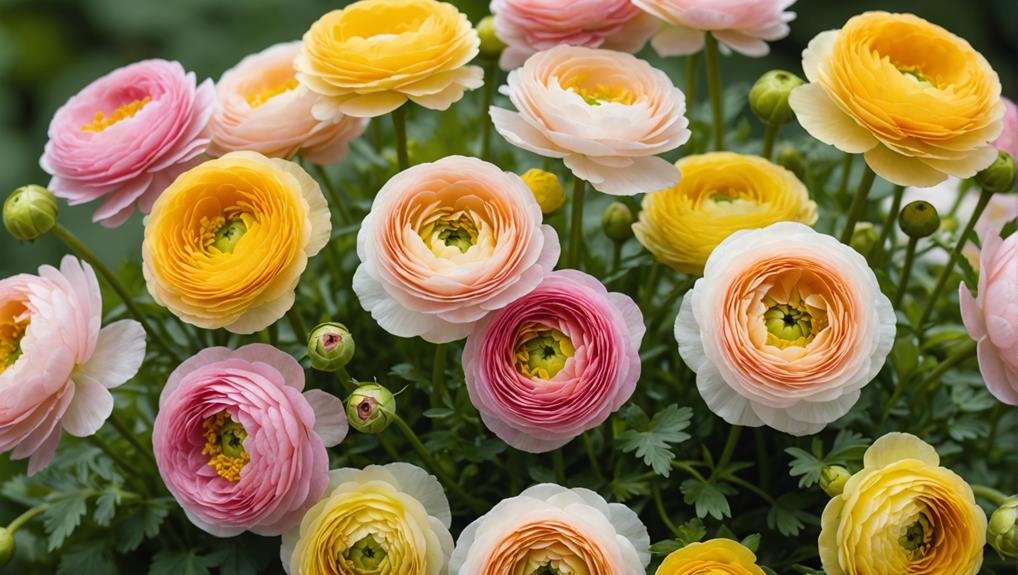
Ranunculus flowers, renowned for their layered petals that create delicate, cup-like blooms, are often mistaken for peonies. Originating from Europe, North Africa, and parts of Asia, these flowers have become a beloved choice in wedding floral arrangements. Their symbolism of joy, happiness, charm, and attractiveness makes them particularly appealing for such special occasions.
Ranunculus blooms are available in a wide array of shades, including pink, yellow, red, orange, and notably, white. This diversity in color allows for versatile design options, enabling florists to craft unique and stunning wedding bouquets. The white ranunculus, in particular, is highly sought after for its elegance and ability to complement various wedding themes and color palettes.
The intricate design of ranunculus flowers, with their multiple layers of petals, adds a touch of sophistication and romance to any bouquet. Their aesthetic appeal and versatility make them suitable not only for bridal bouquets but also for centerpieces and other decorative elements in wedding ceremonies and receptions. The ranunculus’s enduring popularity in weddings is a testament to its beauty and the joy it brings to such memorable events.
Physical Description
Characterized by their intricate layers of delicate petals, these flowers feature a cup-like structure that greatly enhances their visual appeal. Ranunculus flowers are often mistaken for peonies due to their similar appearance, with both showcasing a profusion of layered petals. Each bloom possesses a distinctive small cup shape, making it a mesmerizing focal point in any bouquet.
Available in various shades such as pink, yellow, white, red, and orange, ranunculus flowers offer a broad spectrum of color options. This versatility allows them to seamlessly complement different wedding color schemes, adding a vibrant and sophisticated touch to floral arrangements. As they bloom primarily in the spring and summer months, specifically from March to August, they are a seasonal favorite for weddings held during these times.
In addition to their aesthetic appeal, ranunculus flowers are also an affordable option for couples planning their nuptials. With prices typically ranging between $5 and $10 per stem, they offer a cost-effective way to achieve stunning, lush bouquets without compromising on beauty or quality. Their combination of affordability, versatility, and visual charm makes ranunculus an excellent choice for wedding florals.
Available Colour Varieties
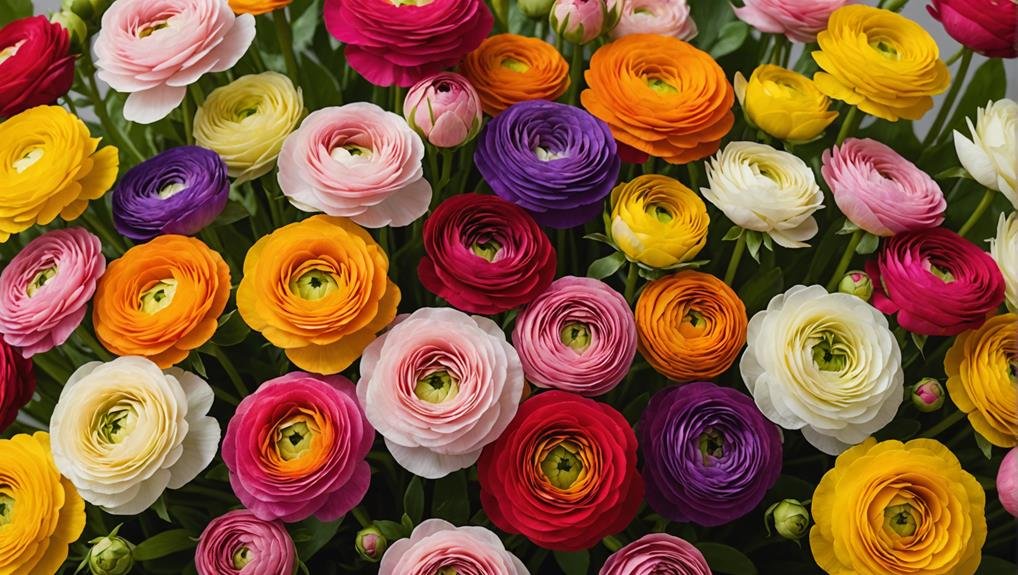
One of the most enchanting features of ranunculus flowers is the extensive array of colors they offer, ranging from soft pastels to vivid hues. This wide spectrum includes shades of pink, yellow, white, red, and orange, allowing couples to select the perfect colors to match their wedding theme.
Pink ranunculus flowers exude a romantic and soft charm, ideal for weddings with a delicate color scheme.
Conversely, yellow ranunculus can brighten any arrangement with their sunny disposition, adding a touch of warmth and cheerfulness.
White ranunculus flowers are timeless and elegant, seamlessly fitting into classic or modern wedding designs.
For those seeking a bolder statement, red ranunculus adds a passionate and vibrant touch, while orange ranunculus introduces a lively and energetic element to the floral decor.
The versatility of ranunculus flowers makes them suitable for any wedding color scheme, whether aiming for a subtle or a vibrant bouquet. These blooms can be effortlessly paired with other flower types to create stunning and diverse bouquet arrangements.
Their colorful petals not only enhance the beauty of wedding bouquets but also bring a sense of vibrancy and joy to the overall celebration.
Latin Name and Taxonomy
The Latin name for this enchanting flower is Ranunculus asiaticus, which falls under the extensive Ranunculaceae family. Renowned for its intricate beauty, this herbaceous perennial plant captivates with its bright, showy flowers that are a favorite in wedding arrangements. Ranunculus flowers are often referred to by their common names, Persian buttercup or turban buttercup, due to their distinctive appearance.
Taxonomically, Ranunculus asiaticus is part of a vast genus that comprises over 600 species, showcasing a remarkable diversity in color and form. Each species within this genus contributes to the rich tapestry of the Ranunculaceae family, renowned for its ornamental and horticultural significance.
One of the standout features of the Ranunculus asiaticus is its multiple layers of delicate petals, which can closely resemble the lushness of roses or peonies. These layers not only add to the flower’s visual appeal but also enhance its textural complexity, making it a sought-after choice for floral designers.
Understanding the taxonomy and botanical characteristics of Ranunculus asiaticus allows for a deeper appreciation of its role in floral artistry, particularly in creating stunning, layered floral arrangements that exude elegance and charm.
Geographical Origins

Native to Europe, North Africa, and parts of Asia, Ranunculus asiaticus thrives in temperate climates conducive to its growth. These regions provide the mild winters and cool summers that ranunculus needs to flourish. The flower’s ability to adapt to various environments has made it a favorite among florists and wedding planners worldwide.
Ranunculus has also found a significant production hub in South America, where growers have capitalized on the continent’s diverse climates to cultivate these flowers year-round. This global spread has guaranteed that ranunculus remains readily available, making it a versatile choice for weddings during its seasonal bloom period from March to August.
Key points about the geographical origins of ranunculus include:
- European Roots: Originating in Europe, ranunculus enjoys the temperate climates found in countries like Italy and France.
- North African Influence: The flower is also native to North Africa, thriving in regions with similar temperate conditions.
- Asian Presence: Parts of Asia, particularly those with mild climates, are home to natural ranunculus populations.
- South American Production: South America has emerged as a major producer, guaranteeing year-round availability and expanding the flower’s global reach.
This geographical diversity underscores the ranunculus’s adaptive nature and its widespread appeal.
Season Availability
Ranunculus flowers are primarily available from March to August, coinciding with their natural bloom period in spring and summer. This period marks the peak season for these vibrant blooms, making them an ideal choice for weddings held during these months. The lush petals and diverse color palette of ranunculus add a touch of elegance and charm to seasonal weddings, perfectly complementing various wedding themes and styles.
For those planning weddings outside the traditional March-August timeframe, it is comforting to note that South America offers year-round production of ranunculus. This continuous availability ensures that couples can enjoy the beauty of ranunculus flowers regardless of their wedding date. Whether in the heart of spring or the height of summer, these blooms provide a consistent option for floral arrangements.
The year-round availability of ranunculus from South America allows florists and wedding planners to incorporate these flowers into bouquets and decorations throughout the year. This flexibility is particularly advantageous for seasonal weddings, as it guarantees that the desired floral aesthetic can be achieved without compromise.
Essentially, ranunculus flowers offer both seasonal charm and year-round reliability, making them a versatile and popular choice for weddings.
Growing Conditions
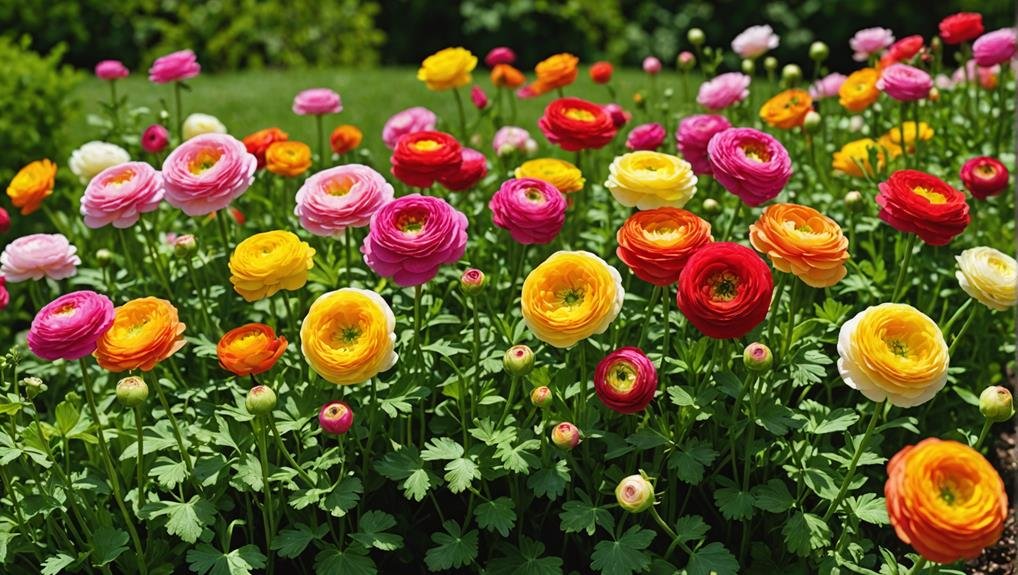
Understanding the best growing conditions for ranunculus is crucial to guaranteeing that these vibrant blooms reach their full potential for wedding arrangements. Ranunculus thrive when specific environmental factors are met, each playing an essential role in their development and bloom quality.
- Full Sun: Ranunculus prefer full sun to partial shade for optimal growth. Guaranteeing they receive ample sunlight is necessary for robust flowering.
- Well-Drained, Fertile Soil: These flowers require well-drained soil rich in organic content. Fertile soil supports their growth by providing necessary nutrients.
- Consistent Watering: Water consistently to maintain soil moisture, but avoid waterlogging. Proper moisture levels are vital for their health.
- Ideal Temperature Range: The optimal temperature range for growing ranunculus is between 50-60°F. This range supports their growth cycle and helps produce vibrant blooms.
Planting ranunculus bulbs in the fall can result in stunning spring blooms, while early spring planting leads to summer flowers. Monitoring soil conditions and maintaining an ideal temperature range are crucial steps for cultivating ranunculus effectively. By adhering to these guidelines, you can ensure that these flowers remain a breathtaking addition to any wedding arrangement.
Cultural Significance
The cultural importance of ranunculus flowers is deeply ingrained in their historical connections with joy, happiness, and delicate beauty across various traditions. Revered for their enchanting appearance, these blossoms have been symbolic of love and passion, making them a key component in wedding ceremonies. Their vibrant hues and intricate petal structures are often viewed as symbols of charm and attractiveness, intensifying the emotional depth of matrimonial events.
In different cultures, ranunculus flowers hold varying significances, adding layers of symbolism to their usage. For example, they are thought to bring good fortune and prosperity to marriages, making them a preferred choice for bridal bouquets and floral arrangements. The rich cultural heritage of these flowers guarantees they remain a cherished element in nuptial celebrations worldwide.
The following table outlines the cultural significance of ranunculus flowers:
| Aspect | Symbolism | Cultural Influence |
|---|---|---|
| Love & Passion | Strong emotions | Enhances romantic expressions |
| Good Luck | Favorable outcomes | Prosperity in marital unions |
| Joy & Happiness | Positive energy | Lively wedding atmosphere |
Incorporating these blooms into wedding decorations not only enhances the ambiance but also infuses it with deep meanings that resonate with couples and their attendees, creating a truly memorable occasion.
Typical Use in Weddings
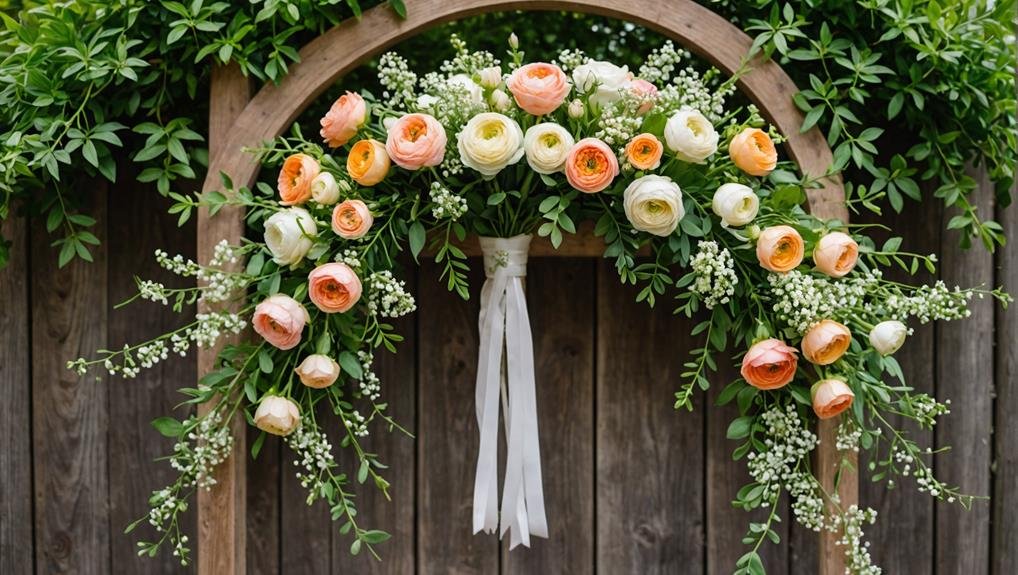
In weddings, these versatile flowers are frequently featured in bridal bouquets, bridesmaid bouquets, boutonnieres, and corsages, adding a touch of charm and elegance to the occasion. Known for their intricate layers and vibrant colors, ranunculus flowers are a popular choice among brides and florists alike. Their adaptability allows them to complement a wide range of wedding styles and color palettes.
Ranunculus can enhance various aspects of wedding decor, providing endless possibilities for floral design. Here are some common uses:
- Bridal Bouquets: Ranunculus flowers are often the focal point in bridal bouquets, contributing a sophisticated and romantic element.
- Bridesmaid Bouquets: These flowers are also a beautiful addition to bridesmaids bouquets, ensuring consistency and harmony in the floral arrangements.
- Centerpieces and Altar Arrangements: Ranunculus are popular wedding flowers for creating stunning centerpieces and altar arrangements, enhancing the overall wedding ambiance.
- Cake Decorations and Place Cards: Beyond bouquets, these blooms can be used to decorate wedding cakes or embellish place cards, adding a cohesive floral touch.
Their versatility and aesthetic appeal make ranunculus a top choice for popular wedding themes, easily blending into various wedding colors and enhancing the overall floral design.
Alternative Flower Types
When ranunculus flowers are unavailable, several alternative flower types can provide a similarly stunning aesthetic for wedding arrangements. Peonies, with their lush, full blossoms, offer a romantic and elegant look that rivals the charm of ranunculus. Anemones, known for their striking centers and delicate petals, can add a touch of sophistication and uniqueness to any bouquet.
Roses are a classic choice, available in many colors and varieties, making them a versatile substitute. For a fresh, springtime feel, tulips and daffodils can bring vibrant color and a sense of renewal to wedding decor. Lilies, with their dramatic and graceful blooms, are another excellent option, adding height and structure to arrangements.
Hydrangeas provide a voluminous and opulent alternative, ideal for creating lush, full bouquets and centerpieces. While these flowers offer distinct aesthetics, they share the ability to enhance wedding arrangements with their beauty and elegance.
